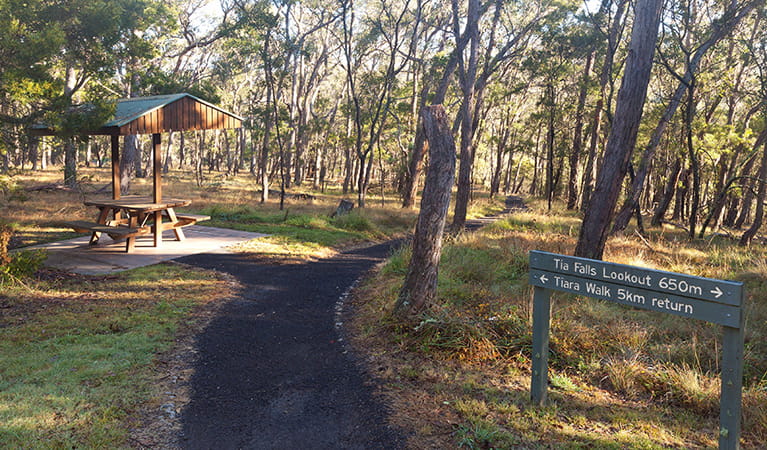Tia Falls campground
Oxley Wild Rivers National Park
Overview
Tia Falls campground offers campsites for cars, caravans and trailers. Great for a weekend trip, it’s near walking tracks and scenic views of waterfalls and gorges.
| Number of campsites | 6 |
|---|---|
| Camping type | Tent, Camper trailer site, Caravan site, Camping beside my vehicle |
| Facilities | Picnic tables, barbecue facilities, toilets |
| Price | There are no camping fees at this campground but a $6 booking fee applies. |
| Bookings | Bookings for up to 2 sites and 12 people can be made online. |
| Group bookings | This campground is not suitable for group bookings. |
| Please note | Sites are marked. |
A small and picturesque campground, Tia Falls campground is set amongst quiet woodland. It’s not far off the Oxley Highway, and a choice of campsites for cars, caravans and trailers make it a great place for a family camping weekend.
There's plenty to keep park explorers busy of a daytime, including the easy Falls walk that offers scenic views from Tia Falls lookout, and the longer Tiara walking track. Evenings offer a chance to relax under the stars, cook up a barbecue feast for dinner, reflect on your day in the park and plan your next adventure.
Map
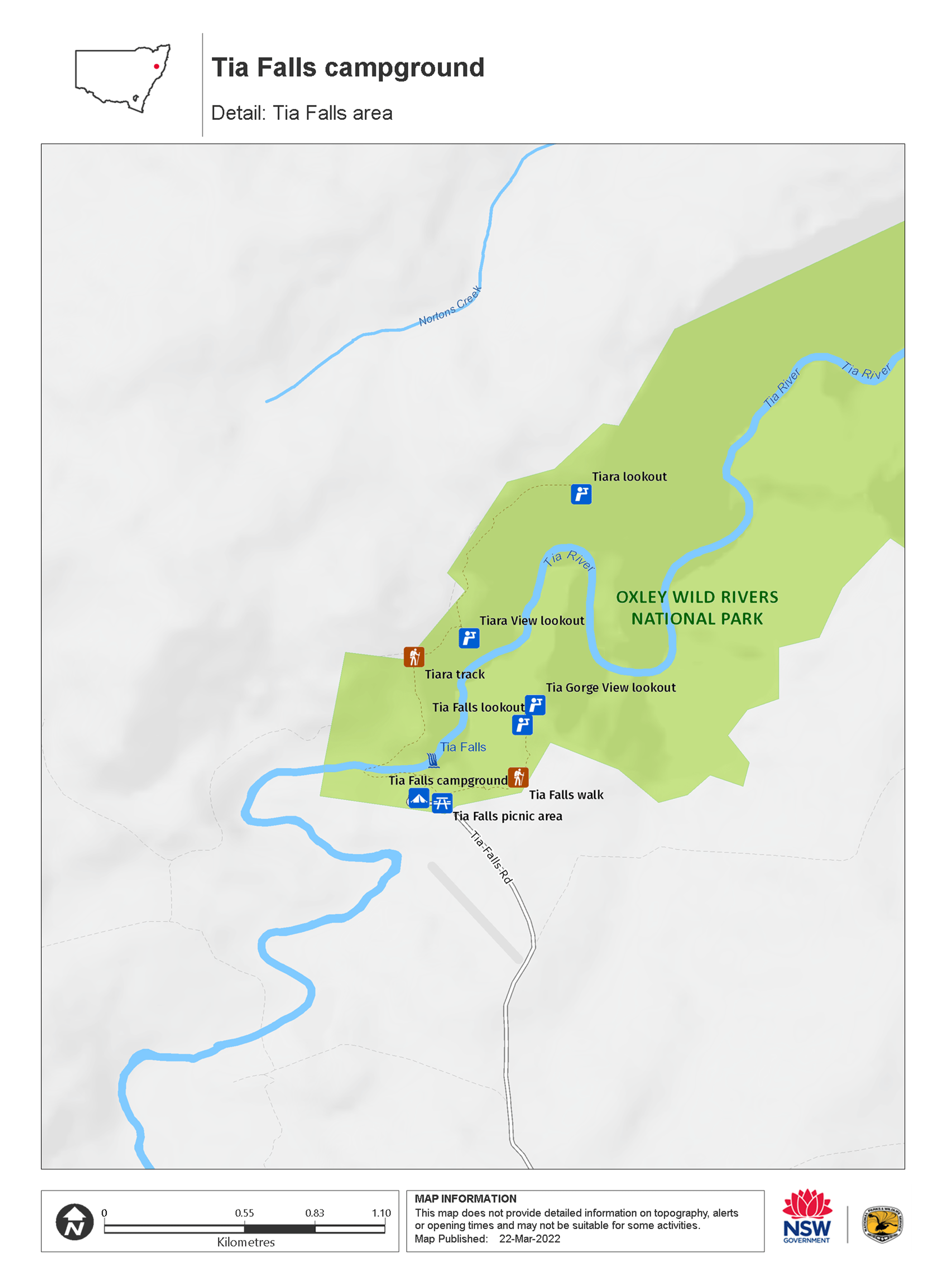
Map legend

Local alerts
For the latest updates on fires, closures and other alerts in this area, see https://www.nationalparks.nsw.gov.au/camping-and-accommodation/campgrounds/tia-falls-campground/local-alerts
Bookings
- National Parks Contact Centre
- 7am to 7pm daily
- 1300 072 757 (13000 PARKS) for the cost of a local call within Australia excluding mobiles
- parks.info@environment.nsw.gov.au
Operated by
- Walcha office
- Monday to Friday, 8.30am to 4.30pm.
- 02 6777 4700
- npws.nea@environment.nsw.gov.au
- 188W North Street, Walcha NSW 2354
Park info
- in Oxley Wild Rivers National Park in the North Coast and Country NSW regions
Oxley Wild Rivers National Park is always open but may have to close at times due to poor weather or fire danger.
-
There are 3 areas in Oxley Wild Rivers National Park where you'll need day use vehicle permits: Halls Peak campground and picnic area, Riverside campground and picnic area, and Youdales Hut campground and picnic area. Day use vehicle permits can be bought online or by calling the National Parks Contact Centre on 1300 072 757. If camping, permit fees are included in the campground fee.
Contact us for permits.
Visitor info
All the practical information you need to know about Tia Falls campground.
Getting there and parking
Tia Falls campground is in the Tia Falls precinct of Oxley Wild Rivers National Park. To get there:
- Take Oxley Highway from Walcha and look for the turn off to Tia Falls, 19km past the Apsley Gorge turn-off.
- Follow this unsealed road/trail for 7km to Tia Falls campground
Road quality
- Unsealed roads
Vehicle access
- 2WD vehicles
Weather restrictions
- All weather
Parking
Parking is available at the Tia Falls campground.
Best times to visit
There are lots of great things waiting for you in Oxley Wild Rivers National Park. Here are some of the highlights.
Autumn
A great time to tackle the Green Gully track when the days are not too hot and the nights not too cold.
Spring
The heathlands are a riot of colour when the flowers are out.
Summer
The waterfalls are likely to be at their most impressive after the summer rains.
Winter
Crisp, cool and clear days are good for a brisk half day bushwalk.
Facilities
Toilets
- Non-flush toilets
Picnic tables
Barbecue facilities
- Wood barbecues (firewood supplied)
Maps and downloads
Prohibited
Pets
Pets and domestic animals (other than certified assistance animals) are not permitted. Find out which regional parks allow dog walking and see the pets in parks policy for more information.
Smoking
NSW national parks are no smoking areas.
Learn more
Tia Falls campground is in Oxley Wild Rivers National Park. Here are just some of the reasons why this park is special:
A national first
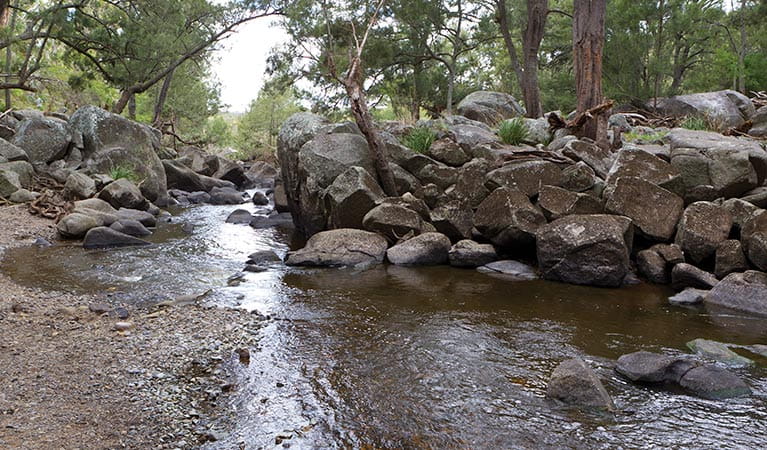
John Oxley was the first European to visit the New England region, passing through the area that is now Oxley Wild Rivers National Park in September 1818. Following Oxley, cedar-getters penetrated the remote and inaccessible gorges followed by pioneer cattle grazers who braved the remote wilderness for a hundred years. Between 1893 and 1894 the first commercial hydro-electric scheme was constructed to power the town and gold mines of nearby Hillgrove. Today you can visit the remains of this historical site when you take a walk along the Threlfall Historic walk.
- Threlfall walking track Threlfall walking track in Oxley Wild Rivers National Park takes in the spectacular Gara Gorge wilderness area, with scenic views and a chance to see the historic hydro-electric scheme.
Abundant wildlife
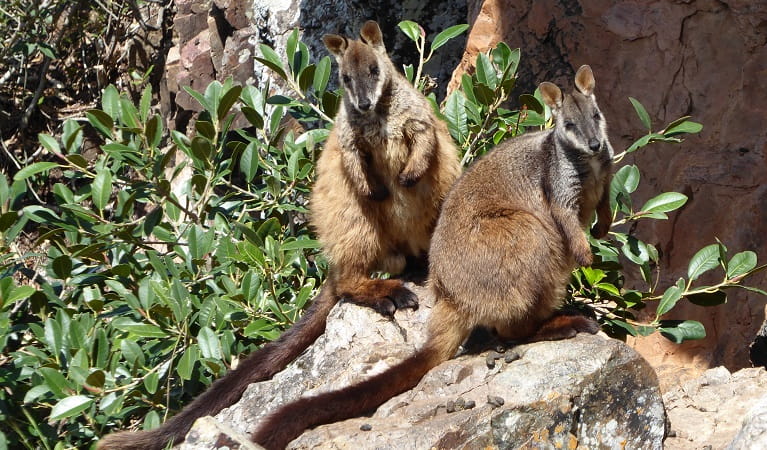
The varied plant communities of Oxley Wild Rivers National Park provide a home for over 350 animal species, including the largest confirmed population of brush-tailed rock wallabies. Even though there are roughly 10,000 of this endangered species in the park, you'll have to keep your eyes open to catch a glimpse of their bushy tail. The park also boasts over 173 bird species, including the majestic wedge-tailed eagle, peregrine falcon, square-tailed kite and sea eagle.
- Dangars Falls walking track Dangars Falls walking track is a great introduction to the waterfalls, rivers and gorges of Oxley Wild Rivers National Park, near Armidale. A short and easy stroll, it delivers you right into the heart of this vast World Heritage Area.
- The Green Gully track Make a booking to experience fern-lined gullies, high elevation forests and wildlife along the Green Gully track. Stay in heritage huts for a break from this challenging multi-day hike.
- Threlfall walking track Threlfall walking track in Oxley Wild Rivers National Park takes in the spectacular Gara Gorge wilderness area, with scenic views and a chance to see the historic hydro-electric scheme.
Ancient lands
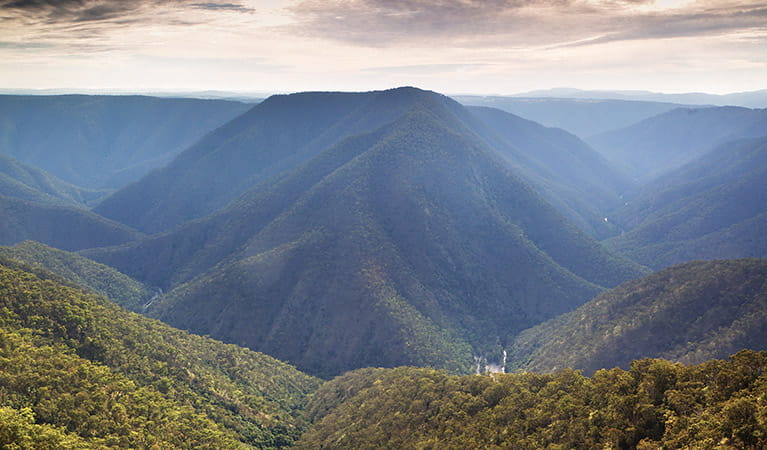
Oxley Wild Rivers National Park is part of the Gondwana Rainforests of Australia World Heritage Area. The park contains some of the best examples of dry rainforest communities in Australia. When you are out exploring the wet and dry eucalypt forests, grassy woodlands and heathlands of the park, look for native olives, lacebarks, shiny-leaved and giant stinging trees, shatterwoods, scentless rosewoods and red kamalas.
- Oxley Wild Rivers guided hiking adventures Explore one of Australia’s largest gorge systems on this multi-day guided trek with Primal Adventures. Experience lush gullies, waterfalls and stunning forests in World Heritage surrounds, near Armidale.
Jaw-dropping scenery
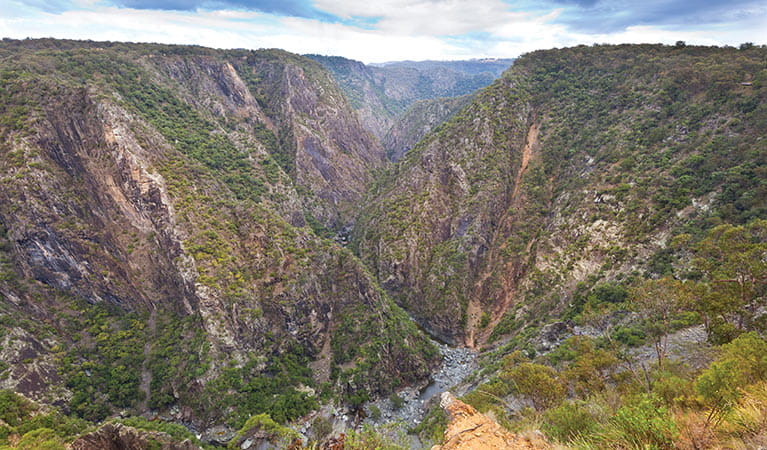
With dramatic ridges and gorges, towering rock outcrops and beautiful rivers and waterfalls, there is something new around every corner and you'll be constantly amazed by the views. The sight of a majestic wedge-tailed eagle soaring high above the gorges looking for food is a truly spectacular sight to behold. Don't forget your camera, give yourself plenty of time and keep your eyes open.
- Budds Mare lookout Enjoy a picnic lunch at Budds Mare lookout surrounded by World Heritage listed rainforest and looking out to spectacular views across the Apsley River.
- Dangars Falls walking track Dangars Falls walking track is a great introduction to the waterfalls, rivers and gorges of Oxley Wild Rivers National Park, near Armidale. A short and easy stroll, it delivers you right into the heart of this vast World Heritage Area.
- The Green Gully track Make a booking to experience fern-lined gullies, high elevation forests and wildlife along the Green Gully track. Stay in heritage huts for a break from this challenging multi-day hike.
- Tia Falls walk Tia Falls walk in Oxley Wild Rivers National Park is great for children. A short, easy walk, it offers spectacular views of Tia Falls and Gorge.
Plants and animals protected in this park
Animals
-

Swamp wallaby (Wallabia bicolor)
The swamp wallaby, also known as the black wallaby or black pademelon, lives in the dense understorey of rainforests, woodlands and dry sclerophyll forest along eastern Australia. This unique Australian macropod has a dark black-grey coat with a distinctive light-coloured cheek stripe.
-
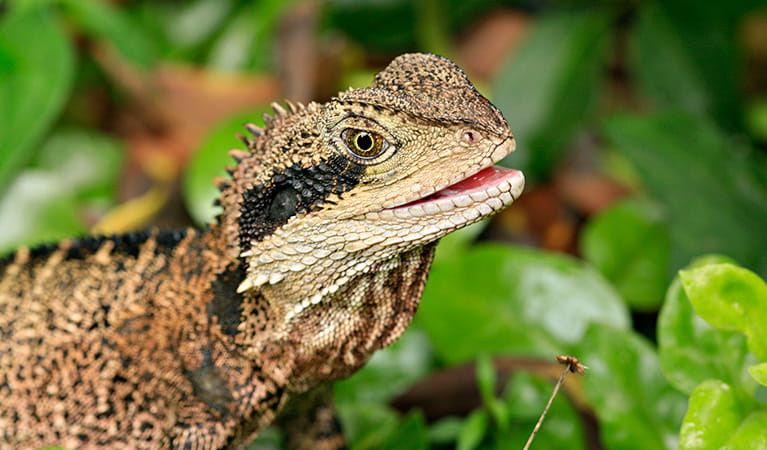
Eastern water dragon (Intellagama lesueurii lesueurii)
The eastern water dragon is a subaquatic lizard found in healthy waterways along eastern NSW, from Nowra to halfway up the Cape York Pensinsula. It’s believed to be one of the oldest of Australian reptiles, remaining virtually unchanged for over 20 million years.
-

Southern boobook (Ninox novaeseelandiae)
The southern boobook, also known as the mopoke, is the smallest and most common native owl in Australia. With a musical 'boo-book' call that echoes through forests and woodlands, the southern boobook is a great one to look out for while bird watching.
-
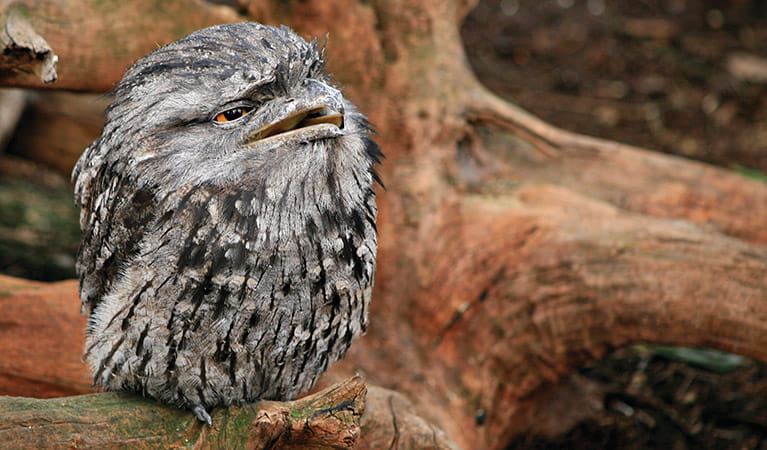
Tawny frogmouth (Podargus strigoides)
Found throughout Australia, the tawny frogmouth is often mistaken for an owl due to its wide, powerful beak, large head and nocturnal hunting habits. The ‘oom oom oom’ call of this native bird can be heard echoing throughout a range of habitats including heath, woodlands and urban areas.
-
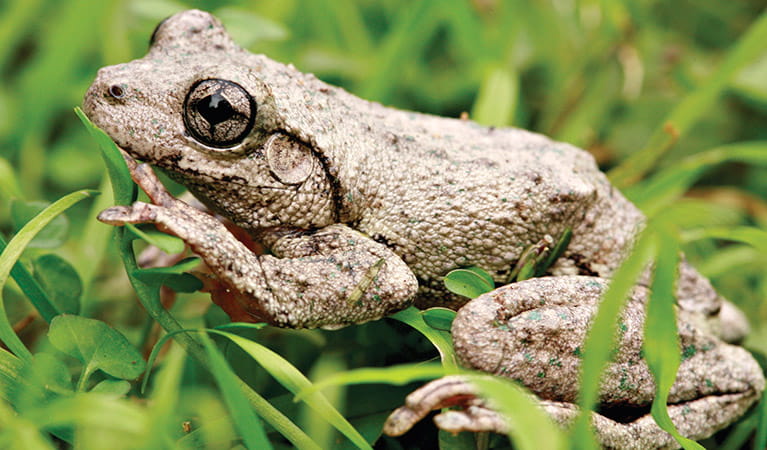
Peron's tree frog (Litoria peroni)
Peron’s tree frog is found right across NSW. These tree-climbing and ground-dwelling Australian animals can quickly change colour, ranging from pale green-grey by day, to a reddish brown with emerald green flecks at night. The male frog has a drill-like call, which has been described as a 'maniacal cackle’.
-
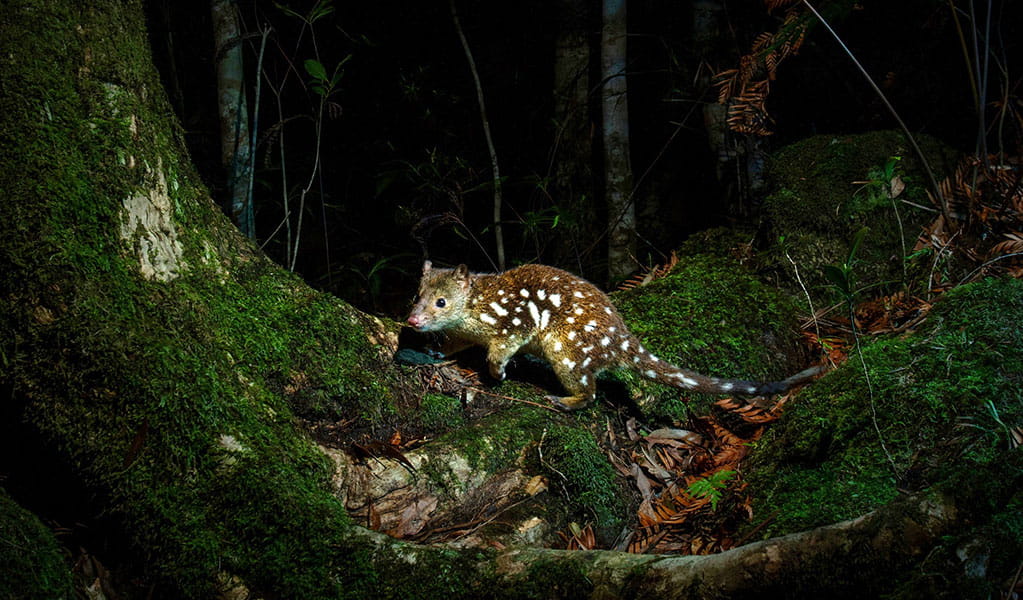
Spotted-tailed quoll (Dasyurus maculatus)
The spotted-tailed quoll is the largest remaining carnivorous marsupial on the Australian mainland. It’s protected as a vulnerable species in NSW.

